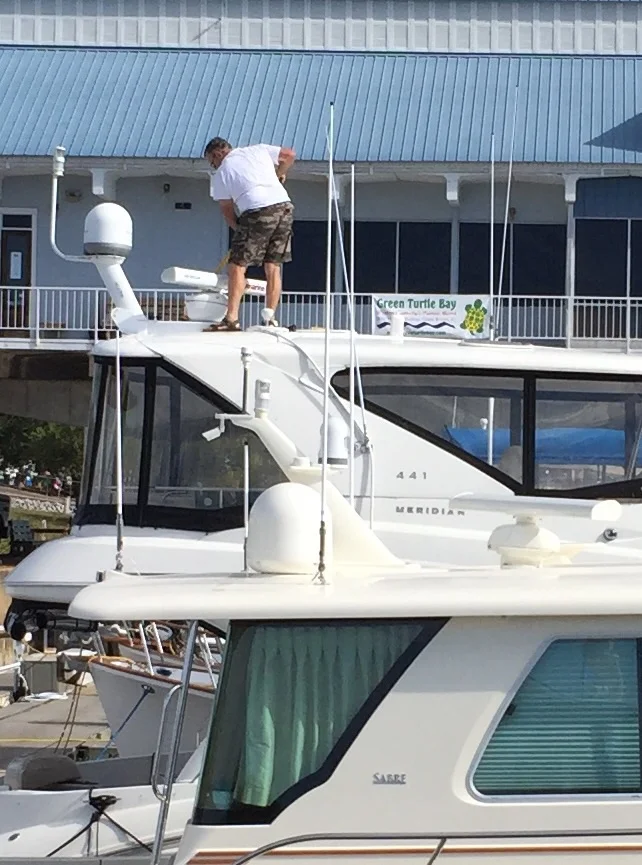Day 16 - He Went to Paris
Miles cruised 41, Fuel purchased 184 gallons, fuel cost $417.00, Slip fee $45
After three delightful days at Green Turtle Bay we fueled up, pumped out and headed out. We crossed over from Lake Barkley / Cumberland River to the Tennessee River / Kentucky Lake via the Barkley Canal. We had traveled this route the day before in Mark’s fishing boat. While fueling up a few of our Looper acquaintances said farewell. Ingrid and Larry were having The Bucket List hauled out to replace their shaft packing gland and possibly their shaft and propeller. They claim to have run over a gill net on Lake Michigan which caused the damage. This limited their ability to go fast on the rivers. The fuel dock attendant talked about all the boats coming to the marina in the spring from Florida that had propellor and shaft damage from large trees floating in the river. His advice was to not be in a hurry to come north in the spring after torrential rains. Anchoring on the rivers in the spring is also dangerous because large trees (not just branches) can foul your anchor chain and drag you down river.
Our stop today is at the Paris Landing State Park Marina/Resort. $1.00 per for with electric and $.75 per foot without electric. The Paris Landing State Resort Park is located along the western shore of Kentucky Lake (the dammed Tennessee River) in Henry County. Containing 841 acres, the park is a major recreational center for northwest Tennessee. Paris Landing was once a steamboat landing in the age of river transportation along the Tennessee. Today the modern park features a large marina, restaurant, resort inn, ten cabins, and a well-regarded eighteen-hole golf course. Other recreational facilities include two swimming pools, campsites, trails, tennis courts, game areas, and picnic grounds.
There are new Loopers (first day) in the slip next to us. They have a 1988 Chris Craft 45′ called Chasing 80. They are chasing 80* f temperatures. So far so good.
Carl (Chef) Wooden – quote of the day.
The chance for mistakes is about equal to the number of crew squared.
– Ted Turner – avid sailor and America’s Cup skipper
My first contribution to the blog.
Andy Arnold aka LaVonne Ruby
Bird Watching on the Rivers:
I have always been fascinated with watching and identifying birds. For the past two weeks while traveling on the rivers we have observed many different birds. The one I will tell you about today is the American White Pelican.
We have been privileged to see many White Pelicans along the Illinois and Mississippi Rivers. While traveling on the Mississippi one day last week, I was excited to see in flight several White Pelicans overhead. They were crossing the river heading for a sand bar along the rivers edge. They joined a flock of one hundred or more White Pelicans gathered on the shore, possibly preparing to continue their migration. A short distance farther down the river we observed more White Pelicans gather on the sand near the shore.
Characteristics of the American White Pelican:
Bodies mostly white except for black-edged wings. Wingspan of 8.5 – 9 feet. Weighs about 16 lbs., imagine a bowling ball with wings. Pelicans have a vertebra in their neck which prohibits them from ever raising their faces. Feeding; White pelicans don’t dive from the air for fish, they float along the water and scoop up fish with their enormous bill. The pelican’s bill can hold up to 3 gallons of water!! From the Nest to Maturity; 1-3 eggs hatch in about a month. Chicks are naked at birth. After 10 days they are covered with white down. At 17 days, chicks leave the nest and join a “pod” of young pelicans. Chicks fledge (leave the nest) when they are 10 weeks old.
A white pelican
Bridge construction on the Tennessee River. A barge severely damaged the old bridge.
Osprey bird nest built on a navigation post on the Barkley canal.
This guy is really into cleaning his boat. Who can see any dirt up there? Don’t fall off!
Brand new Loopers – Chasing 80







